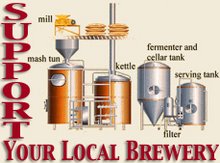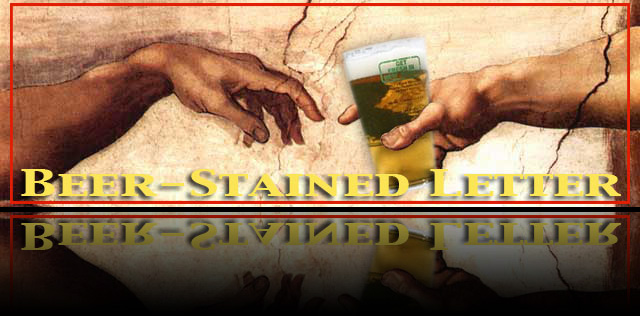 East Coast Beer Company is pilot-brewing an American pale ale to hit the market this year as its second label.
East Coast Beer Company is pilot-brewing an American pale ale to hit the market this year as its second label.
Once again the Point Pleasant Beach company is turning to Tom Przyborowski to shepherd a brew from test batches on a half-barrel homebrewing rig in neighboring Brick Township to commercial production at Genesee Brewing, the beer-maker contracted to produce East Coast's first label, Beach Haus Classic American Pilsner.
A 20-year homebrewer with a taste for English ales, Tom, 48, pilot-brewed Beach Haus, helping to shape the brew that East Coast entered the New Jersey marketplace with late last summer. (Tom has ties to Rochester, N.Y.: It's where he studied photo illustration at Rochester Institute of Technology, and yes, drank plenty of Genesee Cream Ale.)
Tom recently shared a sample pint of the upcoming ale and talked about its R&D progress, what it was like to create Beach Haus pilsner, and revealed that the composers of "Autobahn" were a catalyst to his taking the The Beer Guy job title with East Coast.
BSL: You're now full-time with East Coast Beer. How did your affiliation with the company, with John Merklin and Brian Ciriaco, come about?
TP: I met the founders through a mutual friend, one of my best friends worked with them at their old jobs. He introduced me one day – actually he sent me an email – and he said he wanted me to meet the guys because they wanted to discuss a business venture that involved beer. So I said, "Sounds good, what's the worst that can happen? I'll have dinner and some beers" ... With John I had a mutual connection, the band Kraftwerk. I knew he was a fan; my friend and I were huge fans; he was a huge fan, and although we had never met, we had this kind of a bond through some emails. So I knew that at least he would be a decent guy just because of that.
BSL: What was it about East Coast Beer Company that seemed like a good opportunity?
TP: When they told me what their plan was, basically doing this model, I was on board right away. Every homebrewer dreams of taking the next step. A lot of them find, if they're living in New Jersey, they've got to move to Colorado if they want to take the next step.
SBL: Like Charlie Papazian ...
TP: You gotta move away because it wasn't happening here. So this gave me the opportunity to go from doing 10-gallon homebrew batches to doing 15,500 gallons at a clip, which is pretty overwhelming.
BSL: You guys launched Beach Haus at the tail-end of last summer, and it was pretty popular at some of the festivals then. Talk a little about the R&D of that beer.
TP: The style of beer we were going to do was an accident. We were throwing around the idea of a name in email. John mentioned the words "classic American pilsner" as the name for the beer, and I replied that's a style of beer that no one is really doing.
BSL: Where did the recipe for Beach Haus come from?
TP: By reading some historical information, some older magazines that talked about (the style), and just trying find as much information from old recipes, about the breweries in Newark, the breweries in Brooklyn that were doing that kind of beer, we came up with the recipe for Beach Haus.
BSL: What were some of the early test batches like?
TP: I always do a two-step mash; regardless of the beer I'm doing, I always do a two-step mash. They say you don't need to, but maybe it can't hurt. Also I really think it helps with the head retention, which is obvious in a beer like Beach Haus, because the head just lasts forever. And not all the grains are malted the same way, even though they may be highly modified ... So the two-step mash really, I think, makes a difference, for anybody that's brewing at all.
What I was doing for some of our earlier test batches, my second step, the temperature was too low, and we were making beer that was close to like 7 percent (ABV), but still this light-colored, easy-drinking tasting beer that ends up getting you really wasted because the alcohol was too high. So we modified that second step so we had a more reasonable alcohol (content). But there weren't a lot of changes in the recipe, which is kinda cool.
BSL: How does this translate with Genesee, are they following your specs on this?
TP: Absolutely. We're very involved and they're very receptive. And they really want to make sure they give us what we want. And we do do a two-step with that because the classic American style dictates that you have to have a certain amount of corn. We use corn grits, not corn syrup, so there is a two-step ... the main part of the grain bill starts out at lower temperature while the grits are cooking, then they're added, and it makes that second step.
BSL: What does the corn add?
TP: It actually ferments out fully; it adds a little bit of dryness to (the beer).
BSL: When you were piloting this, you were using the corn?
TP: Yes, flaked maize. It was always part of the grain bill. There's a certain element of flavor that is added – subtle, very subtle, as far as what you taste.
BSL: You guys are in the business of making a beer that reaches a wide audience, but also at the same time you're making a beer that reaches people who are part of the craft beer wave. How does it appeal to those two groups?
TP: People that are into craft beers get it. It's such a pleasure to be at the beer fests and guys come up to the table with their tasting glass and say, "What do you got here?" And you tell them, Classic American Pilsner, and they look at you funny; their beer of choice is Belgian tripels, they have dubbels for breakfast, tripels for lunch, beer tough guys. They'd look at it and see a light-colored beer in front of them; they'd taste it, and then they'd have this look on their face, "Yeah, yeah, this is pretty good."
You'd see that reaction a lot. They all appreciate it for what it is, a style of they're not use to drinking because 10 years ago they stopped drinking pilsner beers when they discovered everything else, and they kinda forgot how good it could be. So when they try it now, people who haven't had it for a while, they respect it, they think it's good beer.
At the same time, they can also take it to other people's (homes), if they're going to visit, instead of bringing a bottle of wine, bring a sixpack of Beach Haus. It won't sit in the refrigerator in the back until the beer geek uncle comes by nine months later and drinks whatever's left over. It'll get drunk by the hosts; the host and hostess will enjoy it as well.
The beers that we make going forward will hopefully have the same level of drinkability, accessibility. We want to have a lot of people like it, and we don't want to have anything, to start out with – (like) our next product that's coming out – too over the top, too overwhelming. We want them to all go along well with food. We want them to be part of the meal, not the appetizer, not one of the courses in the meal, to go along with the meal.
BSL: And so now you're heading back down the path of research and development with an ale.
TP: An American pale ale, yes. Hopefully it will be a year-round (brew). My hope is that it has a really good hop flavor and aroma, with just enough bittering hops that you're drinking something that's a little bit more. But again, not overwhelming. I want it to have that nice floral finish, refreshing, appeal to hop heads but not be overwhelming in the beginning on the tongue.
BSL: We're talking about what kind of alcohol content then, around 5?
TP: Yeah about 5, less than 5 and half. We'll see; we're still tinkering.
BSL: How many incarnations have you produced, and what level of the process are you at?
TP: This is about the fifth different try. We're pretty close. We want to do it a few more times. Hopefully we'll get it sooner than later, of course, but we're not going to just say, "OK, we're done let's just get it out there." We have time now, since it's early in the year, to continue doing test batches. We'll do as many as we feel we need. But now we're zeroing in; we're certainly much closer.
BSL: What are some of the nuances in this process?
TP: Part of the issue is when you go to a different facility, what their yeast is going to do overall. I've done the test batches to be not relying heavily on the yeast.
BSL: You're using a fairly neutral American ale yeast then?
TP: White Labs 001.
BSL: When you go to Genesee, how do they handle the pilot brews?
TP: They'll analyze a sample in their lab and tell us more than we can ever imagine to know about the beer. They'll have the parameters in front of them, and we can go over each element of that.
BSL: How many trips have you made to Rochester?
TP: With Beach Haus we were up there four times before we actually brewed, and for our brewing we were there on the brew day. We were there again for a taste panel, and then we were there again for bottling. We've brewed more than once, so we're always driving up to Rochester; it's better now that the speed limit's faster than when I went to college. But still it's a long drive.
BSL: Which is the harder style to make? Do you think it's more forgiving to be developing an ale versus the pilsner?
TP: I wouldn't say forgiving, but I would say maybe less nerve-wracking. You still have to be as careful, but there's a little more leeway. It's a little more relaxed, because ales themselves are. I'm having fun with the variations (of the test batches), whereas when we did Beach Haus we didn't have any variations. We were always very strict about it.
BSL: You mentioned Summit hops for the ale. You chose that variety why?
TP: It's higher alpha, but you still have the citrus notes, but it has that lower cohumulone.
BSL: How will you know that you've got it, that you've nailed the ale recipe?
TP: Part of it will be, when I first drink it, even when it's still in primary fermentation, transferring to secondary, and maybe while it's doing a little bit of cold conditioning, try it each time and you'll kinda know. If you think of a certain flavor in your head before you drink it, and that matches, you'll kinda know.
But part of it, too, is all the other people who might try that test batch. If 20 other people try it, you can just tell when they're drinking it that they like it. If I know I like it, and 20 other people like it, then hopefully 20,000 people will like it.
This one will be more by committee ... If people who aren't craft beer drinkers like it and people who are craft beer drinkers like it, then you hit the mark. And when it happens we'll know.















